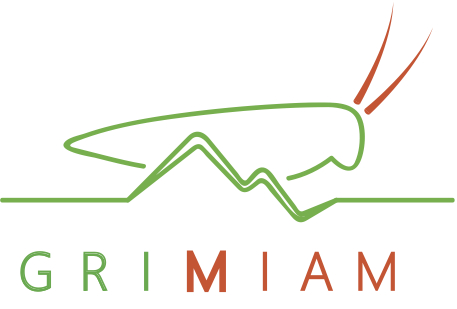 Interview with Jürgen Vogel, President of Grimiam
Interview with Jürgen Vogel, President of Grimiam
Tell us shortly about Grimiam and its activities
This interview comes at the time of an important “metamorphose” for our association.
We will move from a non-profit association into a business structure. After years of successful advocacy, the swiss law will endorse finally three insects as food for human consumption and naturally we will take part in the party as marketers and distributors of insects for the swiss market. So, and to whom it may concern, we are open for mergers, partnerships and products.
We started 2007 to promote edible insects. After years of struggles, we decided in September 2013 to found the Grimiam association calling for new legislative framework on swiss national level, which accepts insects as food for human consumption as well as feed for animals. Once the association was founded…the whole story accelerated. We received the help from Swiss Member of Parliament Isabelle Chevalley, and together with her, three interpellations to the Swiss Federal Council had been launched. Topping those activities and in co-production with swiss company Essento we organized on 10th of March 2014, an insect-cocktail in the Swiss parliament. Besides the ongoing work of advocacy, we continue the media-work and run information-stands and booths in many hypermarkets as well as we take part in public and private events and continue the lobbing all over Switzerland.
Are western people ready for entomophagy or it twill take a real enviromental/food crisis to make us understand that’s time to act and change our food-production system?
It is difficult to answer this question. I only can refer to my experiences in Switzerland. In terms of reasons to eat insects, swiss people are partly convinced by the sustainability and health arguments. But they are not so prepared to actually eat them. Most are disgusted at the idea, even if a small part said however they had already eaten insects, mostly out of curiosity or during travel abroad. Still a large part would try them if they would have the possibility. So nothing is lost yet. Fortunately for us, proteins are the building blocks of life. By the year 2050, after recent research, we will need something like 265 million additional tonnes of protein to feed the growing population and new sources of proteins in view of the rise in China and other countries meat consumption. Even if insects are “not amused”, they stand to be high-grade sources of protein by nature. So, naturally, I do hope that people wake up before the collapse of our system will become reality, as other liveable planets are difficult to find.
Why did you feel the need to write in your site that “the association Grimiam is not against the consumption of meat”?
As Margaret Mead (the famous anthropologist) said: “It is easier to change a man’s religion than to change his diet.” We are often confronted with “meat-lovers” and the question is:“Why do you want to take away my swiss meat?” We wanted to make it clear that we are not against the consumption of meat (especially if it’s swiss meat) but we are against how the conventional meat-industry behaves with the animals, how they waste stupidly our limited resources and how they produce inefficiently in comparison to insects. As it is a burden to convince meat-lovers to change their diets, we give them the recommendation to choose at least ethical reared meat and then…best around the corner from their local farmers.
What’s your opinion about the “state of the art” of the edible insects industry today?
A recent example of insect phobia in the food industry was the revelation that Starbucks was using cochineal beetles as a red colorant in some of its drinks. The uproar caused among consumers, who saw this as a dangerous, “dirty” and unethical practice, pushed the company to replace the insect-derived dye with tomato extracts. Another current problem is the refusal of many traditional food manufacturer to produce insect-products without having an independent “insect-production line”. They are afraid that fragments, flour or dust of insects are found in their traditional products. The ongoing “Ifs & Buts” around insects makes necessary investments a “risk”. Only clear and legal regulations will create transparency and allow predictability for investment decisions.
What’s your development-forecast for the near future?
Today, the majority of meat substitutes are still soy or wheat-protein based, but tomorrow insects-based products will be an alternative and a solution, focusing on the development of meat substitutes closely mimicking the taste and texture of meat products.
For the moment, the idea of using insects as an ingredient is still too weird for most consumers to buy, as well as too weird for most business executives who think that the consumers will never accept them, or accept too slowly to be commercially interesting. Up to us to show them that they are mistaken. All food-trends take their time before they go mainstream. Some do better than others, but all arrive one day in our plates and will be then the expressions of our life-styles and ethical choices. Much will depend of the legal frameworks and regulations and when those will be in force. My forecast is, that the market is growing steadily despite great difficulties. Potatoes took 200 years to be accepted in Europe, lobsters were regarded long time as “food of the poor” but already the famous sushi did it much faster. Additionally and taking in consideration conventional factors in food chemistry and food acceptance (taste, visual, texture, etc.) and application to edible insect preparation, there is no reason why edible insects will not enter in the western diet, over the next two decades, as a common lunch or snack option or a cuisine with high-perceived value.
I am convinced that -within the different existing food trends and market niches like flexitarians, vegans, raw-vegans, raw-foodies, vegetarians, lacto-ovo vegetarians, lacto vegetarian, meat-lovers, fruitarians, paleo diets, etc- the ”insectarians” will find their place. Furthermore I am convinced that the increasing awareness of the ethical and environmental impact of meat will push edible insects as food and feed in the right direction.
Is the “yuk-factor” the biggest problem to solve?
The yuk-factor is certainly a big problem to overcome. If it is the biggest problem, I don’t think so. Even if tomorrow belongs to those who hear it coming, we are still with the same challenges. Overcome legal hurdles, developing mass-production technologies, standards in food and feed safety, developing self-control and ethical standards, consumer acceptance, education and last but not least to guarantee to our future clients smart marketing, competitive prices, good taste, recognizable texture, high quality and constant availability.
Do you believe that in 2017 the EU Institutions will give the normative green light?
After what I hear, read and current rumours, the EU seems not to be ready before 2020 or even beyond. Producers of insects and insects-based products (food) are obliged to submit an application for authorization to the European Commission latest by 2 January 2020. There is a transition period until 01.01.2018. Until this date tolerance in different member states are up for whole insects and products prepared from whole insects (not extracts), under the condition that an application for approval is submitted before 01/01/2018 and until a decision on the dossier is made. I estimate that 2018 marketable edible insect species will have been reduced to some few (3 or 4) and only from 2020 onwards, more insect-species will be recognized as foodstuff. Maybe the feed sector could get a green light in 2017, even if a serious hurdle could be the previous BSE epidemic, and that (out of fear) more research is needed and demanded before insects will be used for animal feed. That could push homologation also to 2020 or later. By the way… we should not forget the “meat-lobby” and its friends. They might perhaps have another vision about the needs for our planet and our source of proteins.
Sorry for my pessimistic point of view about the EU, but let’s finish with a more positive note.
As mentioned in the beginning, here in Switzerland we await the announcement from the Federal Council when the revised law (including three species of insects as foodstuff) will be in force, and whether the draft concerning insects will be accepted. In its early proposition, the ordinance limited the species down to three, (Tenebrio molitor, Acheta domesticus, Locusta migratoria) and their form of usage in only whole insect. After consultation, and if everything goes well, edible insects should be on the market and in the shelves by mid-2017 and hopefully insects can then be handled as whole, but also in fragmented and ground form and thus used in this form as an ingredient within food products. That would give us the possibility to use and transform insect products in the way that are associated, for the consumer, with his or her routine consumption of conventional foods, whereas only whole insects will be good for “Halloween” or as “Party fun”, that’s all. Lets keep fingers crossed & let’s see and wait!
This would be a small step for insects, but a big step for all of us.





